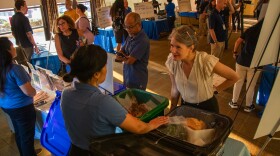There have been lots of studies about active transportation. And ten years ago I was a subject in one of them. One day, a package arrived at my Normal Heights home that contained an electronic box, about the size of a cigarette pack, and a letter asking me to strap the box to my arm for a month to measure my physical activity.
Home To Work In 18 Minutes Afoot
Tom Fudge observes Walk to Work Day with some remarks about his path to KPBS.
I was recruited because I lived in what was considered a very walkable neighborhood. The study sought to find out if the places we lived were a factor in the fight against obesity. UCSD professor Jim Sallis, formerly of San Diego State, designed that study, and he said your neighborhood does matter.
“For obesity, your zip code matters as much as your genetic code!” he said.
The study compared two San Diego neighborhoods; Normal Heights and Clairemont. The latter place is considered very car-dependent.
“And there was a big difference in activity levels, about an hour a week. And that’s a lot of calories, when you think about the number of years you would live in a neighborhood,” Sallis added.
But it gets complicated when you start considering the other things that can lead to obesity. Last year, a new study looked at active commuting, in which people actually walk or bike to work. It found that regions of the country that have the highest rates of active commuting also have some of the lowest rates of obesity and diabetes.
But even in places with the highest rates of active commuting, only about five percent of the population actually bikes or walks to work. Also, the study showed that places with high rates of obesity also had a low median income and low levels of education.
“We just have to not rush into attributing these regional health disparities to car travel,” said Anne Price, a sociologist at University of South Florida Polytechnic. She is co-author of the study, along with her husband Ariel Godwin, with the Central Florida Regional Planning Council.
“What I mean by this,” Price continued, “is we need to look at poverty levels, household income, educational attainment.”
One of the sad ironies of obesity is that low-income people are more likely to be obese. This is true even though low-income people are less likely to be able to afford a car, and are more likely to live in older, less suburban neighborhoods. The Florida study also found the highest obesity rates and lowest rates of active commuting were typically found in the Deep South and Appalachia.
Sallis and others have said obesity’s link to poverty is due to cheap food, which is unhealthy and fattening. He also said we should not assume low-income neighborhoods encourage people to walk. Many of them are unsafe, contain few parks and have beat-up sidewalks.
As to the prevalence of obesity, and heavy car reliance in the South, former-Mississippian Sallis says the influence of culture also makes a difference.
“I know something about that. I grew up in the South. And it is certainly the culture there that if you can drive, you do,” he said.
Yet he says the fact remains; neighborhood design makes a difference, no matter who lives there.
“People in walkable neighborhoods were less likely to be overweight and obese, and that applied also to high income and to low income,” said Sallis. “And we considered their education level, whether they had a car, we adjusted for all of those things.”
The heart of Normal Heights can be found at the corner of Felton and Adams Avenue, and I went there to talk with people about walking.
Mark Presley was pushing a double stroller on Adams with his twin baby girls.
“I walk to the supermarket, to places to eat,” he said. “I go over here to the Lestat’s (coffeeshop) all the time.”
On the other side of Adams I found Tyla Montgomery carrying her yoga mat.
“I’m heading to yoga class,” she said.
“What are some other places you walk to?” I asked.
“I live right next to Vons. I walk to Right Aid, liquor stores, restaurants, you know… If it’s in the neighborhood I walk,” said Montgomery.
Today is national walk to work day. But the tiny percentages of people who actually walk or bike to work show it makes more sense to try to create places like Normal Heights, where people walk to the supermarket or walk to their yoga class.
Meanwhile, there’s money at stake. Congress is still trying to agree on a multi-year transportation bill. One source of disagreement: How many of those billions of dollars should go to creating places that encourage people to walk to the places they want to get to.







